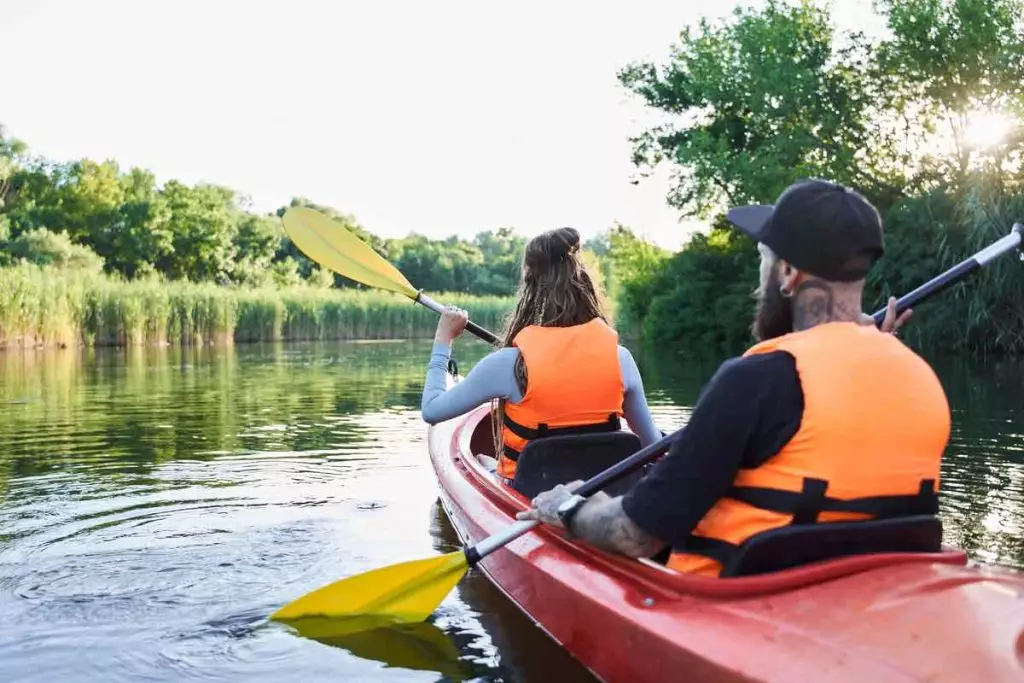Kayaking is an experience that can be both relaxing and exhilarating. There are many stretches of water to explore, including rapid white waters and calm, tranquil rivers. However, how do you know which waters you can kayak through? Can you kayak through private property?
You cannot legally kayak through private property without permission. Most streams, creeks, and inland lakes are privately owned. However, navigable rivers in the United States are considered public property and open to the public for recreational use, even if it runs through private property.
However, before paddling through a waterway in a residential area, know that everything isn’t as black-and-white as it may seem. This article discusses the laws of waterway ownership in the United States to help you determine where you can (and cannot) legally kayak. Read on to learn more.

Waterway Ownership in the United States
Kayaking Through Rivers, Streams, and Creeks
Who owns rivers, streams, and creeks in the United States? Many people are under the assumption that when a waterway runs through private property, the landowner owns that stretch of water. However, this is not the case.
The United States Supreme Court declares navigable rivers as waterways owned by the public. Their respective state governments hold these waterways ” in trust for public use, including recreational purposes. Even if a river runs through a private backyard, as long as it is physically accessible, capable of being navigated, and not deemed off-limits by the government, it is available for public access.
Laws regarding creeks and streams are a bit more complicated. These small bodies of water are often considered part of the landowner’s property; therefore, the public has no right to access these areas. However, this is not always the case, so kayakers are advised to check with a conservation officer to determine whether they’re legally allowed to paddle through these areas.
Land Surrounding Public Waterways
All land surrounding public waterways — including shores and riverbanks — may still be considered private property. Therefore, you cannot leave the vessel, walk along the riverbanks, explore the surrounding land, or wade through the waters (unless you’re portaging; even then, you must move quickly). Never leave trash on public or private property.
Lakes and National Parks
Laws concerning kayaking on rivers in the United States are relatively clear, but regulations surrounding lakes differ. Inland lakes may be public or private property, so it’s vital that kayakers determine the legality of paddling these bodies of water before attempting to access them.
Privately owned lakes require permission from the landowner to access. Public lakes may have specific rules and regulations that boaters must follow, such as no kayaking past dusk.
When requesting permission to kayak on privately owned property, landowners maintain the legal right to charge a fee. Kayaking on privately owned lakes without permission may result in arrest and/or trespassing charges.
In most cases, national parks in the United States follow the federal river laws of the country, meaning they’re open to the public for free recreational use (unless rules state otherwise). However, most nature preserves do not allow popular activities like fishing that may disturb or otherwise harm wildlife, so keep this in mind prior to embarking on the waterway. [XX Reasons Why Kayak Fishing is So Popular]
The Great “Navigable” Waterway Debate
There is a lot of debate surrounding the definition of “navigable” when it comes to public waterways in the United States. There are frequent disagreements, misinformation, and court battles concerning who has the right to these waterways.
The debate arises from a common belief that waterways are only navigable if easily accessed by large vessels, but the definition of navigability depends on context. When determining if the public has free access to a waterway is based on the constitution and defined by federal law. Navigability in this context closely follows the US Army Corps of Engineers definition as covered in 33 CFR 329.
Based on this information, any river that was considered navigable when a state entered the union is held in trust by the state and, therefore, public property. The public has the right to access all navigable waterways for recreational purposes, including kayaking.
Keep in mind, however, that the definition encompasses the majority of rivers within the country but does not include every stream or creek.
Though the federal government remains fairly direct on its rules concerning navigable waters, there are still many who are uninformed or misinformed.
Misinformed Landowners and Law Enforcement
Although a land owner does not hold ownership of any rivers that intersect their property (because most rivers are, by law, public land), many still believe they own this stretch of water. Therefore, to them, any kayaker paddling through is a trespasser.
The ignorance of landowners can lead to many headaches for kayakers. An innocent day of paddling can quickly turn into a nightmare when an upset landowner calls the police to report “trespassers” on “their” property. Even after explaining the law, the kayakers are asked to leave. Unfortunately, even police officers — those we rely on to enforce the law — aren’t always well-versed in federal waterway laws.
Needless to say, this can be extremely frustrating. However, kayakers must be smart and remain respectful, even if they’re legally in the right.
Deranged Landowners and Dangerous Traps
Some landowners have resorted to extreme measures to keep paddlers away from what they deem “their” property. There have been reports of barbed wire strung across rivers and traps placed across streams to prevent boaters from navigating these waterways. This is a clear violation of law and illegally infringes on the public’s right-of-way.
As such, kayakers must remain alert and aware to protect themselves from these potential dangers.
Legal Issues Surrounding Kayaking Near Private Property
Although kayakers are within their legal rights to paddle along a navigable river that crosses private property, the police don’t always know the law and may write a ticket. They may also request that you avoid the area. Despite being right, the best course of action is to use good judgment and not return. It’s not worth it to paddle through this stretch of water if you have to deal with a disgruntled homeowner and the police every time.
If you’re issued a ticket, you can take the case to court (and likely win), though you may find yourself spending hundreds of hours in a courtroom and thousands of dollars on court costs only to declare a small stretch of water open to the public. Whether or not that’s worth it is for you to decide.

Conclusion
According to federal law, state governments own most rivers within the United States. As such, individuals may legally access these waterways for recreational purposes, including kayaking, even if they run through private property.
Creeks and streams are exempt from these laws, so kayakers must speak with a conservation officer or the landowner to determine if the waterway is publicly or privately owned.
For lakes, kayakers must verify whether the water is public or private property. If it is the latter, they must request permission prior to accessing the water.
Sources
- Government Information: Title 33 – Navigation and Navigable Waters
- Cornell University: Montana v. Montana | Supreme Court
- Cornell University: 33 CFR 329 – Definition of Navigable Waters of the United States
- Denver Post: Barbed Wire Fence Gets Loveland Landowner in Hot Water
- Arkansas Game and Fish Commission: Agency Cooperation Deals with Dangerous Barbed Wire Line
- Public Land Water Access Association: Can a Landowner Fence Across a River?
